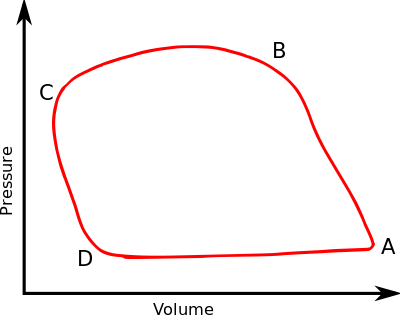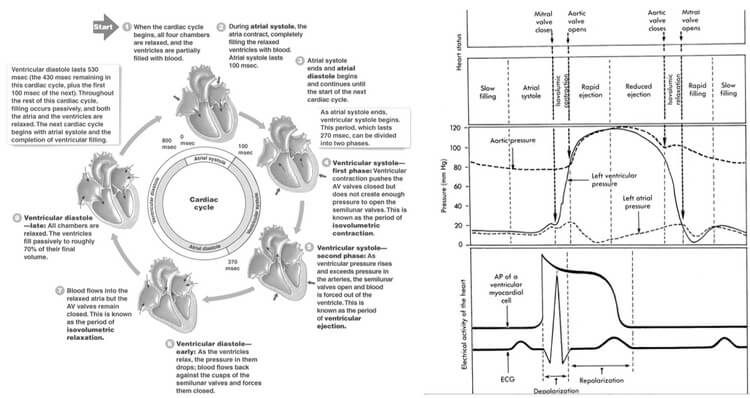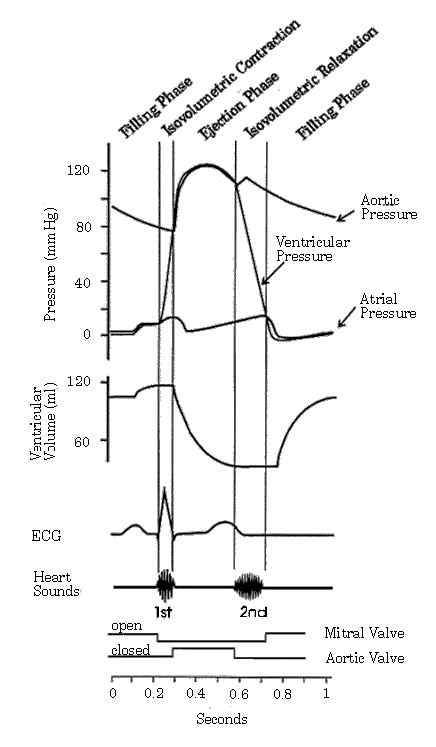42 wiggers diagram khan academy
Diastolic Heart Failure: Symptoms, Causes, Diagnosis ... Symptoms. Common signs of heart failure can include: Shortness of breath. Tiredness, weakness. Swelling in your feet, ankles, legs, or abdomen. Lasting cough or wheezing. Fast or irregular ... The Anatomy of the Heart - Quiz 1 - Free Anatomy Quiz The circulatory system - lower body image, with blank labels attached. The circulatory system - a PDF file of the upper and lower body for printing out to use off-line. Describe and explain the function of the circulatory system - The circulatory system consists of the heart, the blood vessels (veins, arteries, and capillaries), and the blood.
Cardiac Cycle: Meaning, Duration and Phases Phonocardiogram: Refers to graphical recording of heart sounds. Heat sounds can be heard using a stethoscope at specified areas on the precardial region. Almost anyone who is trained better, can hear the 1st and 2nd heart sounds and sometimes the 3rd sound also. But the 4th sound can only be graphically recorded.

Wiggers diagram khan academy
Frank-Starling Mechanism - CV Physiology As described elsewhere, cardiac output increases or decreases in response to changes in heart rate or stroke volume. When a person stands up, for example, cardiac output falls because a fall in central venous pressure leads to a decrease in stroke volume. As another example, limb movement (muscle pump) during exercise enhances venous return to the heart, which causes an increase in stroke volume. Understanding cardiac pressure-volume curves - Khan Academy Practice: Understanding cardiac pressure-volume curves. This is the currently selected item. Practice: Imaging tissue structures using muon tomography. Practice: The effect of contrast agents on MRI signals. Practice: Analyzing electrocardiogram voltage signals. Practice: The mechanics of standing balance. Cardiac Cycle Phases and Blood Flow: Step-By-Step ... - EZmed This post will walk you through one cycle of the heart using a step-by-step diagram that will provide you with easy notes and a simple explanation of cardiac physiology. We will also discuss the blood flow of the heart, and the order of steps that takes place.
Wiggers diagram khan academy. The Cardiac Cycle: Phases, Explanation & Terms - Video ... Diagram showing the flow of blood in the heart What I just described is one cardiac cycle, or the sequence of events in a single heartbeat. Since the average heart beats about 75 beats per minute,... Cardiac Cycle - Wiggers Diagram - YouTube A description of the cardiac cycle using the Wiggers Diagram. en.wikipedia.org › wiki › BathmotropicBathmotropic - Wikipedia Etymology. The term "bathmotropic" is derived from the Ancient Greek word βαθμός (bathmós), meaning "step" or "threshold". [citation needed]History. In 1897 Engelmann introduced four Greek terms to describe key physiological properties of the heart: inotropy, the ability to contract; chronotropy, the ability to initiate an electrical impulse; dromotropy, the ability to conduct an ... Cardiac Cycle - an overview | ScienceDirect Topics Wiggers diagram showing the electromechanical activity of the heart in a cardiac cycle. The figure has been adapted from . During each heartbeat, the ECG recording represents the electrophysiological activity and is obtained using electrodes mounted on the skin.
Cardiac Cycle- Physiology, Diagram, Phases of the Cardiac ... Cardiac Cycle Diagram The diagram below represents the different phases of the cardiac cycle. The atrial systole, ventricular diastole, ventricular systole and ventricular diastole are clearly mentioned in the cardiac cycle diagram given below. Cardiac Cycle Physiology The human heart consists of four chambers, comprising left and right halves. What Are Systolic and Diastolic Blood Pressures? It's highest during the heartbeat (this is the systolic pressure) and lowest between beats (diastolic). A blood pressure reading includes both these measurements. Doctors measure blood pressure in these numbers so that there is a standard way of describing the force of the pulsing blood. Both the systolic and diastolic pressures are important. PDF The Cardiac Cycle Worksheet Answers Wiggers Diagram Anatomy \u0026 Physiology Online - Cardiac conduction system and its relationship with ECG Khan Academy MCAT Vid 2: Pressures in the Cardiac Cycle The Cardiac Cycle Cardiac Cycle The Cardiac Cycle Cardiac Cycle in 3 Minutes [Physiology] How your heart works - Cardiac Cycle LLTC 2020 Room 2 Home [canvas.ocps.net] Teacher & Staff Login. Parent. Login. Other. Login
Lub dub (video) | Circulatory pathways | Khan Academy So the white arrows represent the correct flow of blood, and the black arrows represent the incorrect flow of blood. So these valves shut down like that. So now you can see how the valves, the aortic and pulmonary valve, are actually closed when the mitral and tricuspid valve are open. So what happens after this? Online Wiring Diagram This kind of image ( Vacuum Hose Diagram For 2000 Accord 2.3 - Honda-Tech - Honda Forum with regard to 2000 Honda Accord Engine Diagram) over is labelled together with: 2000 honda accord 4 cylinder engine diagram, 2000 honda accord engine bay diagram, 2000 honda accord engine compartment diagram, . submitted by simply admin on March, 1 2015. 2. The Cardiac Cycle - SimpleMed - Learning Medicine ... Diagram - Wiggers diagram. This shows the cardiac cycle, including the various pressures and volumes around the heart, an ECG trace (showing the electrical activity of the heart) and a phonocardiogram (showing the heart sounds - each sound corresponds to a valve shutting). It is excellent for understanding what happens in each section of the ... Cardiac Inotropy (Contractility) - CV Physiology In this figure, the control loop has an end-diastolic volume of 120 mL and an end-systolic volume of 50 mL. The width of the loop (end-diastolic minus end-systolic volume) is the stroke volume (70 mL). When inotropy is increased (at constant arterial pressure and heart rate) SV increases, which reduces the end-systolic volume to 20 mL.
› programmeProgramme | DATE 2022 Thomas Wiggers, University of Amsterdam, NL Abstract Dutch Nao Team is a team of bachelor and master students from the University of Amsterdam that program robots to play football autonomously. Dutch Nao Team competes in the RoboCup SPL League and competitions around the world. 17:10 CET: 9.1.2: SQUADRA CORSE POLITO Speaker and Author:
Khan Academy MCAT Vid 2: Pressures in the Cardiac Cycle ... This is a brief tutorial of aortic, ventricular, and atrial pressures in the cardiac cycle using a Wiggers diagram.
42 2007 kia sorento serpentine belt diagram This kind of image ( Vacuum Hose Diagram For 2000 Accord 2.3 - Honda-Tech - Honda Forum with regard to 2000 Honda Accord Engine Diagram) over is labelled together with: 2000 honda accord 4 cylinder engine diagram, 2000 honda accord engine bay diagram, 2000 honda accord engine compartment diagram, . submitted by simply admin on March, 1 2015.
Wiggers diagram steps Flashcards - Quizlet Start studying Wiggers diagram steps. Learn vocabulary, terms, and more with flashcards, games, and other study tools.
Cardiac Cycle Phases and Blood Flow: Step-By-Step ... - EZmed This post will walk you through one cycle of the heart using a step-by-step diagram that will provide you with easy notes and a simple explanation of cardiac physiology. We will also discuss the blood flow of the heart, and the order of steps that takes place.
Understanding cardiac pressure-volume curves - Khan Academy Practice: Understanding cardiac pressure-volume curves. This is the currently selected item. Practice: Imaging tissue structures using muon tomography. Practice: The effect of contrast agents on MRI signals. Practice: Analyzing electrocardiogram voltage signals. Practice: The mechanics of standing balance.
Frank-Starling Mechanism - CV Physiology As described elsewhere, cardiac output increases or decreases in response to changes in heart rate or stroke volume. When a person stands up, for example, cardiac output falls because a fall in central venous pressure leads to a decrease in stroke volume. As another example, limb movement (muscle pump) during exercise enhances venous return to the heart, which causes an increase in stroke volume.






































Comments
Post a Comment